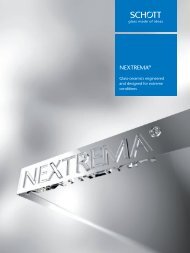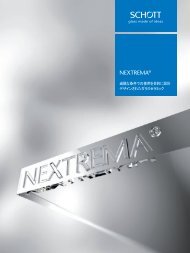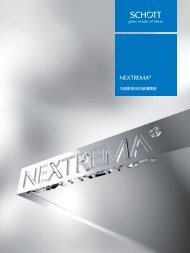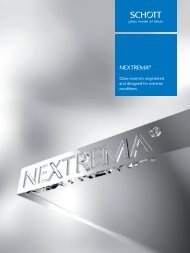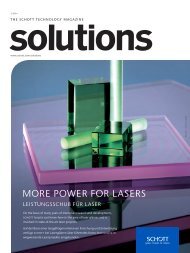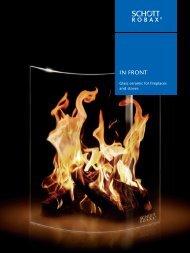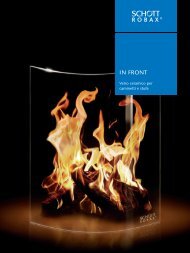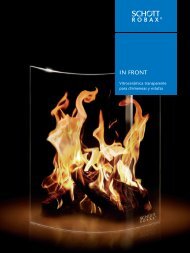SCHOTT Technical Glasses
Apart from its application in optics, glass as a technical material has exerted a formative influence on the development of important technological fields such as chemistry, pharmaceutics, automotive, optics, optoelectronics and information technology. SCHOTT Technical Glasses offers pertinent information in concise form. It contains general information for the determination and evaluation of important glass properties and also informs about specific chemical and physical characteristics and possible applications of the commercial technical glasses produced by SCHOTT. With this brochure, we hope to assist scientists, engineers, and designers in making the appropriate choice and make optimum use of SCHOTT products.
Apart from its application in optics, glass as a technical material has exerted a formative influence on the development of important technological fields such as chemistry, pharmaceutics, automotive, optics, optoelectronics and information technology. SCHOTT Technical Glasses offers pertinent information in concise form. It contains general information for the determination and evaluation of important glass properties and also informs about specific chemical and physical characteristics and possible applications of the commercial technical glasses produced by SCHOTT. With this brochure, we hope to assist scientists, engineers, and designers in making the appropriate choice and make optimum use of SCHOTT products.
You also want an ePaper? Increase the reach of your titles
YUMPU automatically turns print PDFs into web optimized ePapers that Google loves.
7<br />
1<br />
behavior, are characteristic features of this glass type.<br />
Examples: Ion exchange glass types AS87 (8787) and<br />
LAS80 (8785).<br />
Aluminoborosilicate glasses<br />
Alkaline-free aluminoborosilicate glasses<br />
Typically, these glasses essentially consist of 55 – 65 % SiO 2 ,<br />
15 – 20 % Al 2 O 3 , 5 – 10 % B 2 O 3 and about 10 to 15 % alkaline<br />
earth oxides, without any additions of alkali oxides. A low<br />
coefficient of thermal expansion combined with high transformation<br />
temperature and good chemical stabilities makes<br />
them especially useful as substrate glasses for flat panel<br />
displays.<br />
Examples: substrate glasses for TFT displays AF37 (8264)<br />
and AF32 (8266).<br />
Alkali-lead silicate glasses<br />
Such glasses typically contain over 10 % lead oxide (PbO).<br />
Lead glasses containing 20 – 30 % PbO, 54 – 58 % SiO 2 and<br />
about 14 % alkalis are highly insulating and therefore of<br />
great importance in electrical engineering. They are used in<br />
lamp stems.<br />
Lead oxide is also of great importance as an X-ray protective<br />
component in radiation shielding glasses.<br />
Alkali alkaline earth silicate glasses<br />
(soda-lime glasses)<br />
This is the oldest glass type. It comprises flat glasses (window<br />
glass) and container glasses, which are produced in<br />
large batches. Such glasses contain about 15 % alkali (usually<br />
Na 2 O), 13 – 16 % alkaline earths (CaO + MgO), 0 – 2 %<br />
Al 2 O 3 and about 71 % SiO 2 .<br />
Different versions of the basic composition can also contain<br />
significant amounts of BaO with reduced alkali and alkaline<br />
earth content. Example: 8350.<br />
Also belonging to this group are glasses with higher BaO<br />
content for X-ray protection such as those used in technical<br />
applications requiring radiation shielding. On a broader<br />
plane, certain crystal glasses (drinking glasses) can also be<br />
included.<br />
LAS-glass-ceramics<br />
Ingredients for the production of special glasses<br />
Due to their outstanding properties, crystallizable glasses in<br />
the Lithium-Aluminium-Silicate (LAS) system have achieved<br />
high commercial significance. Key properties are very low,<br />
even zero thermal expansion, optical transparency and high<br />
chemical resistance. Characteristically, these glasses contain<br />
3 – 6 % Li 2 O, 18 – 25 % Al 2 O 3 , 58 – 75 % SiO 2 (crystal constituents),<br />
2 – 6 % TiO 2 + ZrO 2 (nucleating agents) and about 2 %<br />
alkaline and alkaline earths to improve glass melting (residual<br />
glass formers). MgO, ZnO and P 2 O 5 can also enter the crystalline<br />
phase to form solid solution crystals. Coloration of<br />
glass-ceramics (by adding coloring oxides like V 2 O 5 , Fe 2 O 3 ,<br />
CoO, NiO, MnO 2 ) creates black CERAN ® cooktop panels.<br />
Transparent glass-ceramics are used in ROBAX ® fireplace windows,<br />
CERAN CLEARTRANS ® cooktop panels with underside<br />
coating, PYRAN ® Platinum fire resistant glazings, ZERODUR ®<br />
precision articles and a broad range of special applications<br />
under the trade name NEXTREMA ® .<br />
Examples: CERAN HIGHTRANSeco ® 8712, ROBAX ® 8724






